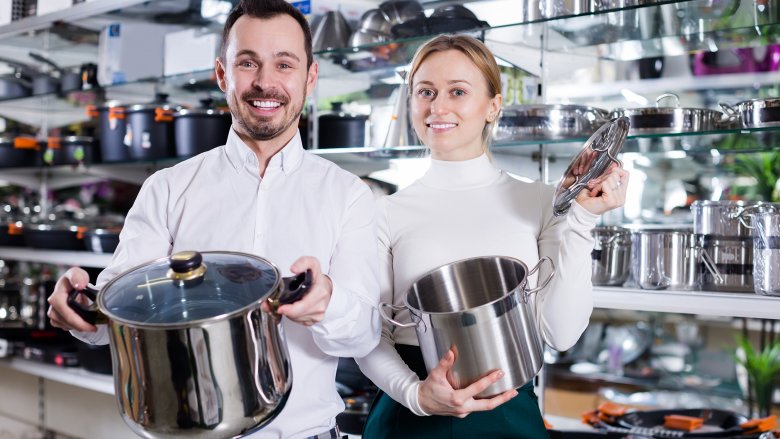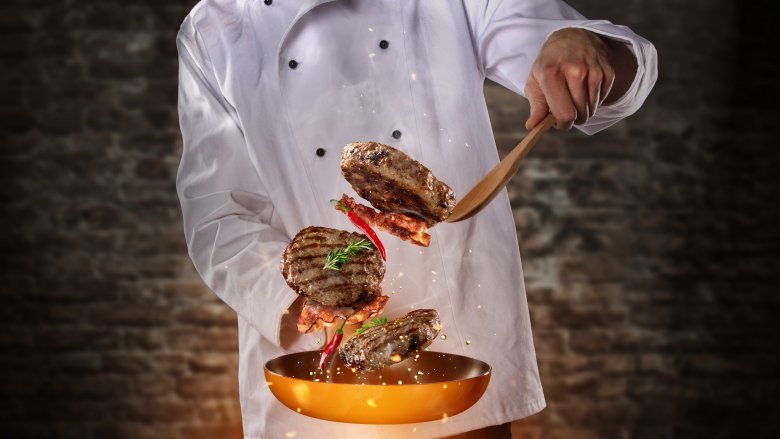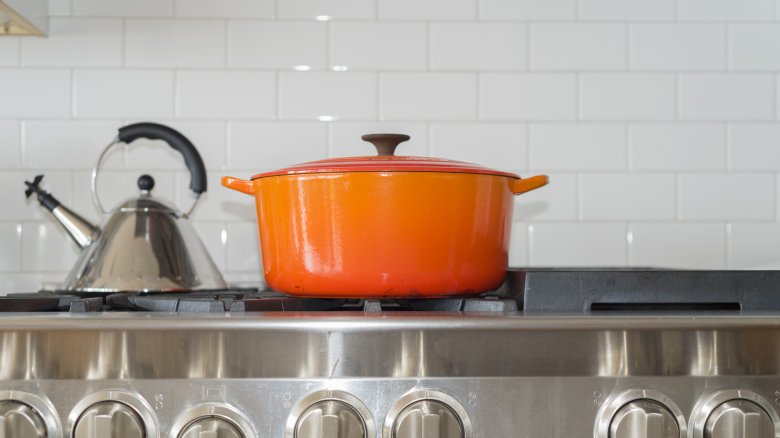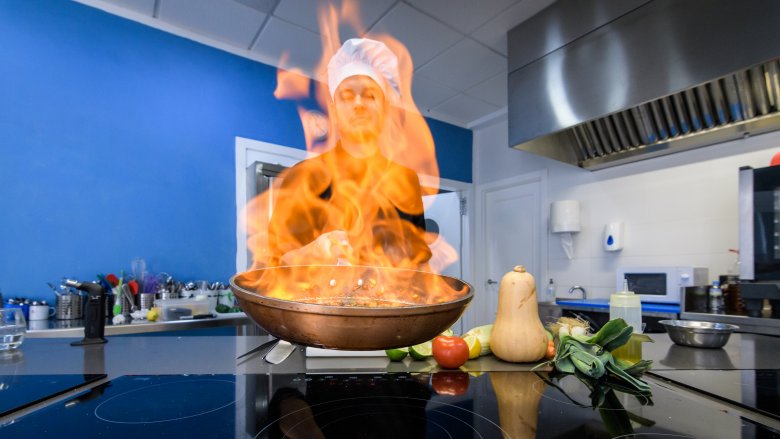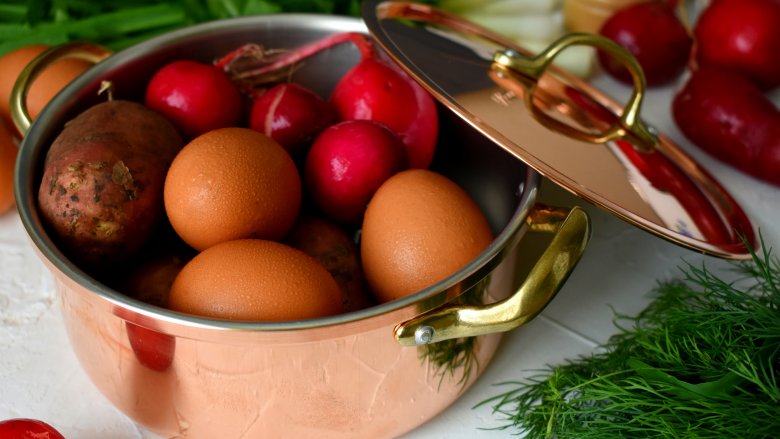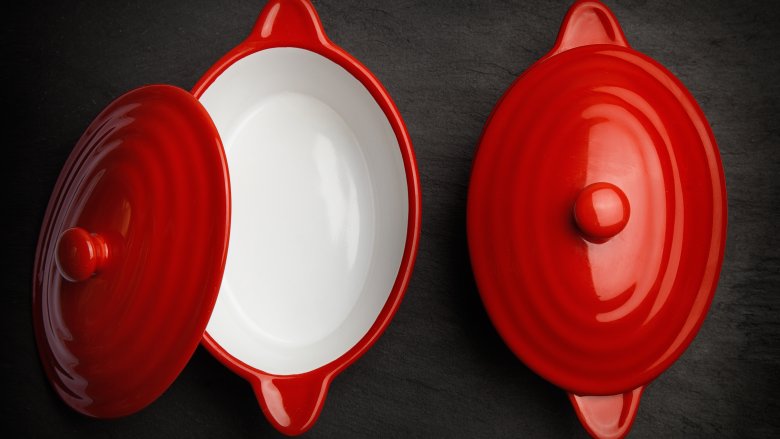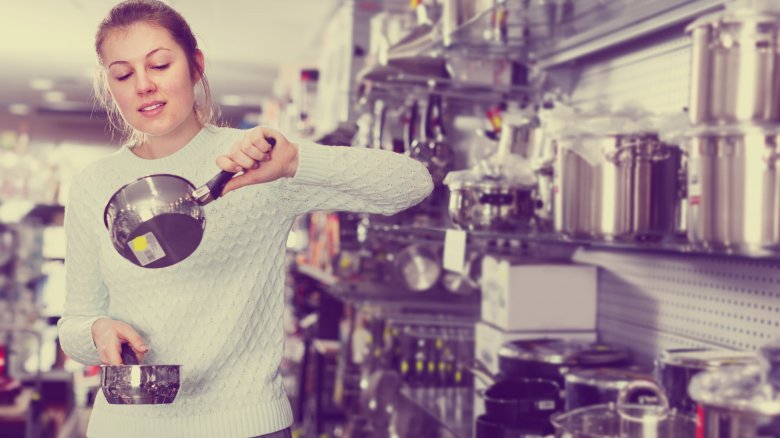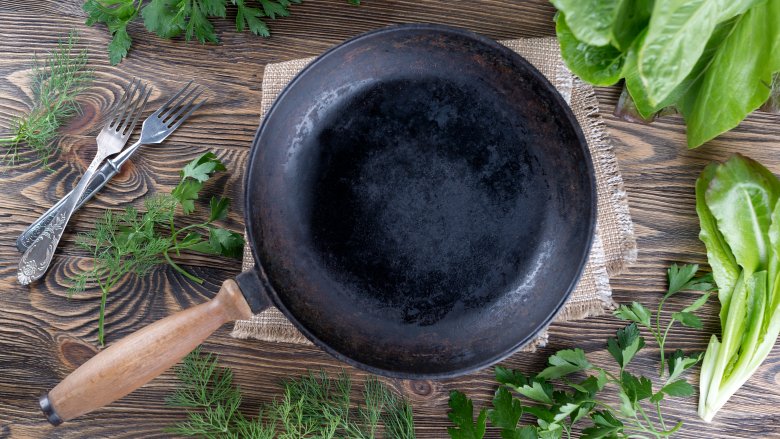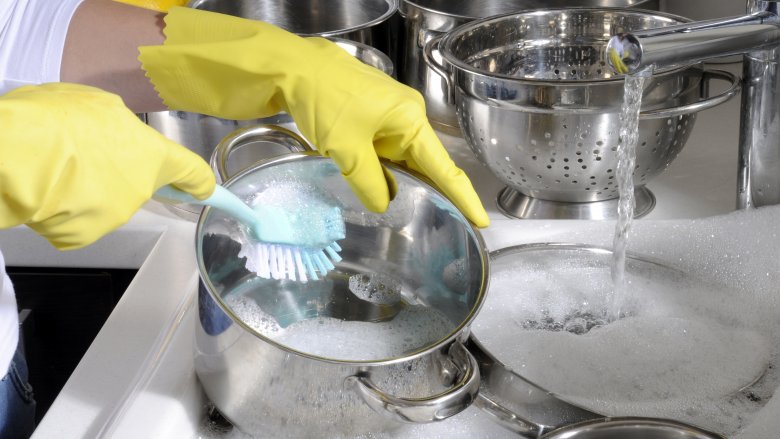The Truth About Expensive Pots And Pans
When it comes time to outfit your kitchen with the cookware that you hope is going to last at least more than a few months, you'll find something pretty shocking. There's a wide range of prices when it comes to pots and pans, and that's putting it mildly. Sure, you can go to your favorite big box store and pick up a full set of all different sizes for $50... or, you can drop several hundred dollars on a single pan.
What gives? At the end of the day, they're just pots and pans, right? They all have the same basic function — make food hot — and they all sit on the stove in pretty much the same way. There are no moving parts, they're pretty basic, and how on earth do manufacturers justify charging that much?
It's a completely legitimate question as to whether or not you should spend the equivalent of a few car payments outfitting your kitchen, and the answer is a bit complicated. Let's talk science, cooking, and how you should really go about buying those pots and pans.
Reactivity, non-reactivity, and combination metals
Those are some very sciency words, and that's appropriate. Cooking really is a science after all, and that's where the quality of your pots and pans comes in.
Cheap pots and pans are typically made of a metal that's either reactive or non-reactive. How Stuff Works explains it like this: if you're cooking something acidic (think tomato sauce or foods with lemon), a reactive pan is going to, well, react with your ingredients to ultimately change the taste of the food. You don't want that, so what you do want is a non-reactive pan. The problem with non-reactive pans is that they're generally not as good when it comes to conducting heat and warming the surface of the pan evenly.
And that's where your more expensive pots and pans have a huge advantage over the cheap ones. While cheap pans tend to be made of one metal, higher quality ones are often a combination of metals. Reactive metals, like aluminium, make up the core of the pot while non-reactive metals are used in the coating that's actually going to touch your food. You'll get the best of both worlds.
Heat management
More expensive, high-quality pots and pans have something else going for them, too. They're made in such a way that they're good heat conductors, and that makes a huge difference.
Let's use a quick example: you're sauteing garlic, and we all know there's that sweet spot between just right and too much. A pan that's a good conductor will heat up fast, and when you get to that sweet spot with your garlic, you can pull it off the heat source and have it cool down almost immediately so nothing burns.
According to Fine Cooking, well-made pots and pans also tend to be thicker, which leads to a more even heat that's applied to your food. Heat evens out as it spreads from the source, so the more pan it has to spread through, the better — it'll prevent you from getting a super hot spot in the middle of the pan. That larger, thicker pan is also going to hold more heat, so no matter what you're doing, you're essentially going to get a more even heat distribution and, in turn, a more even cook.
You get what you pay for
It's an old saying: "You get what you pay for." It's a saying that's been around so long because it's absolutely true, and part of the reason high-quality cookware costs so much is simply that it's made better.
Generally, the more expensive the pan, the higher the quality of construction. That's a big deal because for starters, you're not going to need to replace them as often and over the lifespan of your pan, the costs could very well even out. You'll still have a $100 pot after years, but you might have to replace that $25 pot a bunch of times because of broken handles or a scratched surface. Longevity will help it make that initial purchase price seem not-so-bad.
There's more, too, says How Stuff Works. Most expensive pans will be better balanced, easier to use, and that's going to make you less likely to drop and damage them. Handles will last longer and be more secure, and when you're dealing with hot food, that's worth it right there, isn't it?
Why handles are important
Those handles are actually pretty important, and here's why.
Anthony Bourdain probably put it best when he talked about just what makes a good saute pan in Kitchen Confidential. He wrote, "A thin-bottomed saucepan is useless for anything. ... A proper saute pan, for instance, should cause serious head injury if brought down hard against someone's skull. If you have any doubts about which will dent — the victim's head or your pan — then throw that pan right in the trash."
And it goes without saying that you'll need a well-constructed handle to take the weight of a pan that heavy.
There's a bit more to handles, too. High-quality (ie. expensive) pots and pans tend to have handles that aren't just stronger, but they're also heat-proof. Even better, notes Fine Cooking, are the ones that are oven-proof, because that means you can start cooking on the stovetop and put the entire pan in the oven to finish.
When all-copper is all-bad
Copper pans are great, but if you're wondering if you should spend the money for a nice set to use every day, the answer is "no."
It's tricky — and there's little to no hard data out there on it — but Fine Cooking notes that copper pots can leach copper into the food you're cooking. If you're only using them every so often, you're probably fine. But since people only need a very, very small amount of copper in their diet and can only excrete a limited amount of excess copper, using copper pots and pans every day for everything could lead to some health problems. And, if you're using copper pans for acidic foods — like tomato sauce — you're going to end up ingesting even more of it because of their reactive properties.
There's even a medical condition that makes copper pots even more dangerous. It's called Wilson Disease, and a low-copper diet is one of the biggest needs for anyone diagnosed with it.
That said, there's no evidence that using copper pots once in a while causes any ill effects — but you shouldn't worry about spending the money for all-copper, everyday-use pans.
You don't need them all
Cheaper pots and pans tend to come in sets. They might be handy to have, but those box sets shouldn't make you think that you need to spend a fortune upgrading every single one.
Consumer Reports says the very first thing you should consider — even before you pick out a particular range or style you're fond of — is what, exactly, you like to cook. Is your family fond of pastas and slow-cooked sauces, or are they more of a steak-and-potatoes bunch? Do you do a lot of burgers? Soups? Casseroles? Whatever the answer is, it'll help you decide which pots and pans you really should invest in.
Say you do a lot of casseroles in the oven. If that's the case, investing in a single, high-end casserole dish is for you. Do you spend all winter slow-cooking soups on the stove-top? Then think about getting a really nice stock pot. You don't need the whole set, just upgrade the ones you use all the time and you'll get a few really nice pieces to use all the time, and you won't feel like you're breaking the bank.
There are still pros and cons with the expensive stuff
Not every high-end pot is made the same, so doing some research ahead of time and comparing brands' pros and cons to your own cooking habits (and kitchen habits) might save you some serious headaches in the future.
Let's talk about some of the examples Consumer Reports assembled. Enameled cast iron, for example, is great for slow-cooking and braising because of the way it heats up. It also looks stylish enough to double as a serving dish, and it'll still impress at the most high-pressure dinner party. But, it's extremely heavy. Coupled with a tendency to chip, you might damage this one pretty easily.
Copper pots and pans can get damaged and dented pretty easily, too, so if you don't have a place to store these where they're not going to get banged around, they might not be for your kitchen. Then, there's carbon-steel and blue-steel. They're durable and they're used in a ton of professional kitchens, but they're high-maintenance and often highly specialized when it comes to use. Not even the most expensive tools are perfect, so it's important to do some serious research before you start spending.
Sometimes, it's not worth buying new, but...
Some of the most expensive pots and pans are meant to last a lifetime, so that means you might not have to pay full price for a decent set after all. If you're not in a hurry, flea markets, antique malls, and even eBay can have some incredible finds — especially when it comes to brands like La Creuset and other enameled cast iron.
And when it comes to cast iron, you're better off searching for vintage pots and pans, anyway! According to Good Housekeeping, vintage cast iron — that's stuff from the 19th and early 20th century — was handmade to be easier to handle, easier to season, and more lightweight. And all that makes it better.
If you decide to go the hand-me-down route, just look closely at the pots and pans before you buy. Make sure there's no dents or chips, but also keep in mind that some handles can be replaced. Seeing original stickers on the piece is a bonus: just think of how many people were given a nice, high-end piece of cookware for a wedding gift and then never unpacked it? You can benefit.
They're only as good as the care you give them
More expensive pots and pans might be high-quality and more durable than cheaper alternatives, but in the end, they're only as good as the care you give them. That probably means not treating them the same as the pans you're used to, and each type of pot or pan needs different type of care.
Take enameled cast iron. Those can be put in the dishwasher, says Consumer Reports, but you should never use kitchen sponges that are even the slightest bit abrasive. Cast iron is going to take a lot of care and seasoning, and there's still a chance it'll rust. (That can be easily fixed.) Copper pans might require a specific commercial copper cleaner, and they can be easily ruined by using the wrong material. Fortunately, following the manufacturer's care instructions will prolong the life of your pots and pans so your single investment might be one that you also make for future generations of chefs.
